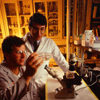 A retired unicycling dermatologist has gotten press, and a few laughs, by claiming a link between testosterone and humor.
A retired unicycling dermatologist has gotten press, and a few laughs, by claiming a link between testosterone and humor.
Sam Shuster of Newcastle upon Tyne, U.K., rode around town on his unicycle for a year, recording the reactions of 400 passersby. Reporting in the 22 December 2007 issue of the British Medical Journal, Shuster relates that about 75% of male reactions were “attempts at comedy,” whereas 95% of the females “praised, encouraged, or expressed concern.” The most aggressive reactions came from youthful males, who shouted things such as “Fall off, granddad” and kicked soccer balls at him. Responses mellowed with time, Shuster observed, with older men joking about his having lost a wheel or his handlebars. Elderly men tended to comment on the difficulty, saying things such as “It’s quicker to walk.” Shuster’s interpretation is that as men age, “aggression is concealed by wit.” He speculates that humor eventually takes on a life of its own, persisting beyond high testosterone levels.
Sociologist Alan Booth of Pennsylvania State University in State College is skeptical of a testosterone-humor connection–except “to the extent humor means demeaning someone.” Aggression is “probably just one aspect” of humor, suggests psychologist Roy Baumeister of Florida State University in Tallahassee. He says that in his experience, men are often more likely than women to use self-deprecating humor, hardly an expression of aggression.
Originally appeared in Science Magazine as a Random Sample: [html] [pdf]


